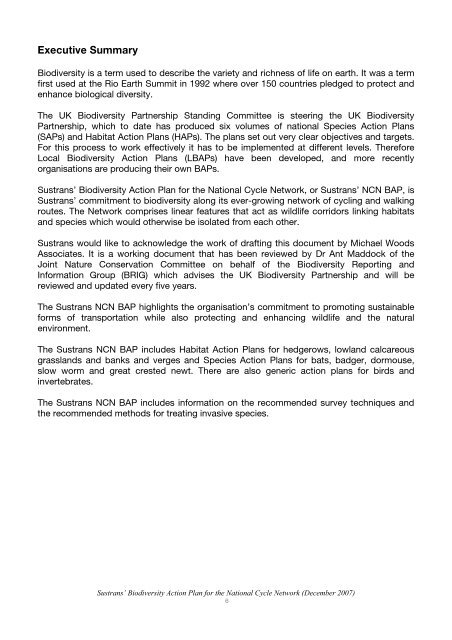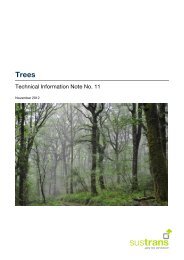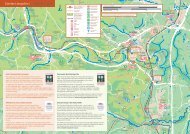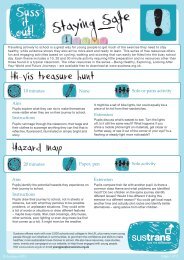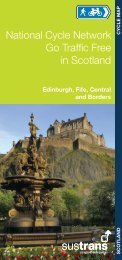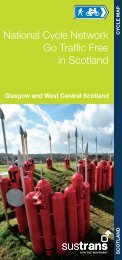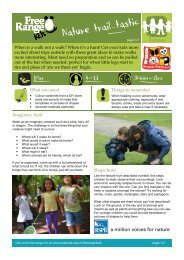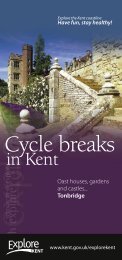Biodiversity Action Plan for the National Cycle Network ... - Sustrans
Biodiversity Action Plan for the National Cycle Network ... - Sustrans
Biodiversity Action Plan for the National Cycle Network ... - Sustrans
You also want an ePaper? Increase the reach of your titles
YUMPU automatically turns print PDFs into web optimized ePapers that Google loves.
Executive Summary<br />
<strong>Biodiversity</strong> is a term used to describe <strong>the</strong> variety and richness of life on earth. It was a term<br />
first used at <strong>the</strong> Rio Earth Summit in 1992 where over 150 countries pledged to protect and<br />
enhance biological diversity.<br />
The UK <strong>Biodiversity</strong> Partnership Standing Committee is steering <strong>the</strong> UK <strong>Biodiversity</strong><br />
Partnership, which to date has produced six volumes of national Species <strong>Action</strong> <strong>Plan</strong>s<br />
(SAPs) and Habitat <strong>Action</strong> <strong>Plan</strong>s (HAPs). The plans set out very clear objectives and targets.<br />
For this process to work effectively it has to be implemented at different levels. There<strong>for</strong>e<br />
Local <strong>Biodiversity</strong> <strong>Action</strong> <strong>Plan</strong>s (LBAPs) have been developed, and more recently<br />
organisations are producing <strong>the</strong>ir own BAPs.<br />
<strong>Sustrans</strong>’ <strong>Biodiversity</strong> <strong>Action</strong> <strong>Plan</strong> <strong>for</strong> <strong>the</strong> <strong>National</strong> <strong>Cycle</strong> <strong>Network</strong>, or <strong>Sustrans</strong>’ NCN BAP, is<br />
<strong>Sustrans</strong>’ commitment to biodiversity along its ever-growing network of cycling and walking<br />
routes. The <strong>Network</strong> comprises linear features that act as wildlife corridors linking habitats<br />
and species which would o<strong>the</strong>rwise be isolated from each o<strong>the</strong>r.<br />
<strong>Sustrans</strong> would like to acknowledge <strong>the</strong> work of drafting this document by Michael Woods<br />
Associates. It is a working document that has been reviewed by Dr Ant Maddock of <strong>the</strong><br />
Joint Nature Conservation Committee on behalf of <strong>the</strong> <strong>Biodiversity</strong> Reporting and<br />
In<strong>for</strong>mation Group (BRIG) which advises <strong>the</strong> UK <strong>Biodiversity</strong> Partnership and will be<br />
reviewed and updated every five years.<br />
The <strong>Sustrans</strong> NCN BAP highlights <strong>the</strong> organisation’s commitment to promoting sustainable<br />
<strong>for</strong>ms of transportation while also protecting and enhancing wildlife and <strong>the</strong> natural<br />
environment.<br />
The <strong>Sustrans</strong> NCN BAP includes Habitat <strong>Action</strong> <strong>Plan</strong>s <strong>for</strong> hedgerows, lowland calcareous<br />
grasslands and banks and verges and Species <strong>Action</strong> <strong>Plan</strong>s <strong>for</strong> bats, badger, dormouse,<br />
slow worm and great crested newt. There are also generic action plans <strong>for</strong> birds and<br />
invertebrates.<br />
The <strong>Sustrans</strong> NCN BAP includes in<strong>for</strong>mation on <strong>the</strong> recommended survey techniques and<br />
<strong>the</strong> recommended methods <strong>for</strong> treating invasive species.<br />
<strong>Sustrans</strong>’ <strong>Biodiversity</strong> <strong>Action</strong> <strong>Plan</strong> <strong>for</strong> <strong>the</strong> <strong>National</strong> <strong>Cycle</strong> <strong>Network</strong> (December 2007)<br />
6


